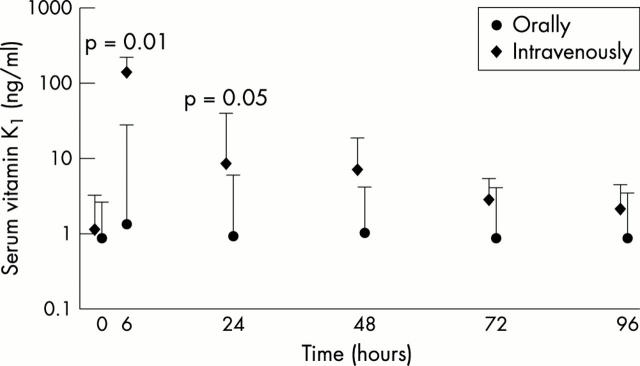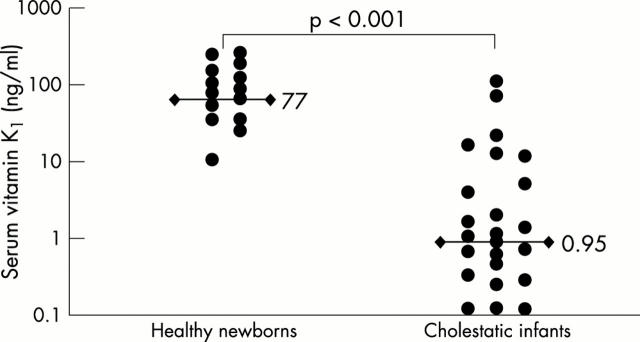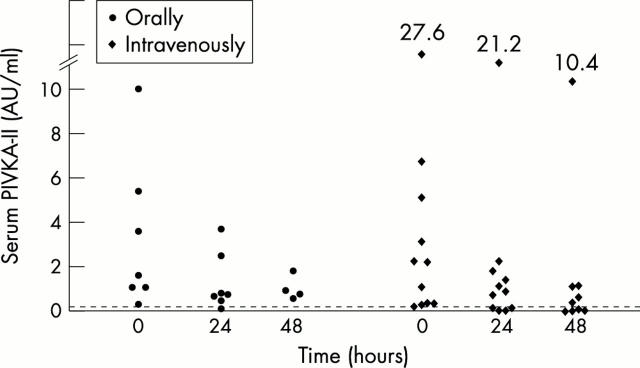Abstract
Objective: To compare the pharmacokinetics and efficacy of oral versus intravenous mixed micellar vitamin K prophylaxis in infants with cholestatic liver disease, a known risk factor for vitamin K deficiency bleeding.
Design: Prospective randomised controlled study.
Setting: Paediatric Liver Unit.
Patients: Forty four infants less than 6 months of age with conjugated hyperbilirubinaemia.
Main outcome measures: Serum concentrations of vitamin K1 and undercarboxylated prothrombin (PIVKA-II; a sensitive functional indicator of vitamin K status) before and for up to four days after a single dose of mixed micellar K1 1 mg intravenously or 2 mg orally. Comparison of K1 levels 24 hours after oral K1 with those from 14 healthy newborns given the same dose.
Results: At admission, 18 infants (41%) had elevated levels of serum PIVKA-II and eight (18%) had low K1 concentrations, indicative of subclinical vitamin K deficiency. Median serum K1 concentrations were similar in the oral and intravenous groups at baseline (0.92 v 1.15 ng/ml), rising to 139 ng/ml six hours after intravenous K1 but to only 1.4 ng/ml after oral administration. In the latter group, the low median value (0.95 ng/ml) and wide range (< 0.15–111 ng/ml) of serum K1 compared unfavourably with the much higher levels (median 77, range 11–263 ng/ml) observed in healthy infants given the same oral dose, and suggested impaired and erratic intestinal absorption in cholestatic infants. The severity of malabsorption was such that only 4/24 (17%) achieved an incremental rise in serum K1 > 10 ng/ml.
Conclusions: The intestinal absorption of mixed micellar K1 is unreliable in infants with conjugated hyperbilirubinaemia. Given the strong association between cholestasis and late vitamin K deficiency bleeding, these data provide an explanation for the failure of some oral vitamin K1 prophylaxis regimens in infants with latent cholestasis.
Full Text
The Full Text of this article is available as a PDF (211.2 KB).
Figure 1 .
Median (SE) serum vitamin K1 concentrations in 44 infants with conjugated hyperbilirubinaemia before and after the administration of mixed micellar K1 2 mg orally or 1 mg intravenously.
Figure 2 .
Individual serum vitamin K1 levels in healthy newborns and cholestatic infants 24 hours after the oral administration of a 2 mg dose of mixed micellar K1. The horizontal bars represent the median values.
Figure 3 .
PIVKA-II profile in the cholestatic infants with initially raised serum PIVKA-II before treatment, and at 24 and 48 hours after mixed micellar vitamin K1 2 mg orally or 1 mg intravenously. The dashed horizontal line at 0.15 AU/ml represents the limit of sensitivity of the assay and the upper limit of normal in healthy adults.
Selected References
These references are in PubMed. This may not be the complete list of references from this article.
- Amédée-Manesme O., Lambert W. E., Alagille D., De Leenheer A. P. Pharmacokinetics and safety of a new solution of vitamin K1(20) in children with cholestasis. J Pediatr Gastroenterol Nutr. 1992 Feb;14(2):160–165. doi: 10.1097/00005176-199202000-00007. [DOI] [PubMed] [Google Scholar]
- Barton J. S., Tripp J. H., McNinch A. W. Neonatal vitamin K prophylaxis in the British Isles: current practice and trends. BMJ. 1995 Mar 11;310(6980):632–633. doi: 10.1136/bmj.310.6980.632. [DOI] [PMC free article] [PubMed] [Google Scholar]
- Belle M., Brebant R., Guinet R., Leclercq M. Production of a new monoclonal antibody specific to human des-gamma-carboxyprothrombin in the presence of calcium ions. Application to the development of a sensitive ELISA-test. J Immunoassay. 1995 May;16(2):213–229. doi: 10.1080/15321819508013559. [DOI] [PubMed] [Google Scholar]
- Bhanchet P., Tuchinda S., Hathirat P., Visudhiphan P., Bhamaraphavati N., Bukkavesa S. A bleeding syndrome in infants due to acquired prothrombin complex deficiency: a survey of 93 affected infants. Clin Pediatr (Phila) 1977 Nov;16(11):992–998. doi: 10.1177/000992287701601106. [DOI] [PubMed] [Google Scholar]
- Chuansumrit A., Isarangkura P., Hathirat P. Vitamin K deficiency bleeding in Thailand: a 32-year history. Southeast Asian J Trop Med Public Health. 1998 Sep;29(3):649–654. [PubMed] [Google Scholar]
- Cornelissen M., von Kries R., Loughnan P., Schubiger G. Prevention of vitamin K deficiency bleeding: efficacy of different multiple oral dose schedules of vitamin K. Eur J Pediatr. 1997 Feb;156(2):126–130. doi: 10.1007/s004310050570. [DOI] [PubMed] [Google Scholar]
- Ekelund H. Late haemorrhagic disease in Sweden 1987-89. Acta Paediatr Scand. 1991 Oct;80(10):966–968. doi: 10.1111/j.1651-2227.1991.tb11763.x. [DOI] [PubMed] [Google Scholar]
- Forsgren L. Studies on the intestinal absorption of labelled fat-soluble vitamins (A, D, E, and K) via the thoracic-duct lymph in the absence of bile in man. Acta Chir Scand Suppl. 1969;399:1–29. [PubMed] [Google Scholar]
- Gijsbers B. L., Jie K. S., Vermeer C. Effect of food composition on vitamin K absorption in human volunteers. Br J Nutr. 1996 Aug;76(2):223–229. doi: 10.1079/bjn19960027. [DOI] [PubMed] [Google Scholar]
- Golding J., Greenwood R., Birmingham K., Mott M. Childhood cancer, intramuscular vitamin K, and pethidine given during labour. BMJ. 1992 Aug 8;305(6849):341–346. doi: 10.1136/bmj.305.6849.341. [DOI] [PMC free article] [PubMed] [Google Scholar]
- Greer F. R., Marshall S. P., Foley A. L., Suttie J. W. Improving the vitamin K status of breastfeeding infants with maternal vitamin K supplements. Pediatrics. 1997 Jan;99(1):88–92. doi: 10.1542/peds.99.1.88. [DOI] [PubMed] [Google Scholar]
- Greer F. R., Marshall S. P., Severson R. R., Smith D. A., Shearer M. J., Pace D. G., Joubert P. H. A new mixed micellar preparation for oral vitamin K prophylaxis: randomised controlled comparison with an intramuscular formulation in breast fed infants. Arch Dis Child. 1998 Oct;79(4):300–305. doi: 10.1136/adc.79.4.300. [DOI] [PMC free article] [PubMed] [Google Scholar]
- Greer F. R., Marshall S., Cherry J., Suttie J. W. Vitamin K status of lactating mothers, human milk, and breast-feeding infants. Pediatrics. 1991 Oct;88(4):751–756. [PubMed] [Google Scholar]
- Hagstrom J. N., Bovill E. G., Soll R. F., Davidson K. W., Sadowski J. A. The pharmacokinetics and lipoprotein fraction distribution of intramuscular vs. oral vitamin K1 supplementation in women of childbearing age: effects on hemostasis. Thromb Haemost. 1995 Dec;74(6):1486–1490. [PubMed] [Google Scholar]
- Hanawa Y., Maki M., Murata B., Matsuyama E., Yamamoto Y., Nagao T., Yamada K., Ikeda I., Terao T., Mikami S. The second nation-wide survey in Japan of vitamin K deficiency in infancy. Eur J Pediatr. 1988 Jun;147(5):472–477. doi: 10.1007/BF00441969. [DOI] [PubMed] [Google Scholar]
- Hansen K. N., Ebbesen F. Neonatal vitamin K prophylaxis in Denmark: three years' experience with oral administration during the first three months of life compared with one oral administration at birth. Acta Paediatr. 1996 Oct;85(10):1137–1139. doi: 10.1111/j.1651-2227.1996.tb18216.x. [DOI] [PubMed] [Google Scholar]
- Hathaway W. E. New insights on vitamin K. Hematol Oncol Clin North Am. 1987 Sep;1(3):367–379. [PubMed] [Google Scholar]
- Humpl T., Brühl K., Brzezinska R., Hafner G., Coerdt W., Shearer M. J. Fatal late vitamin K-deficiency bleeding after oral vitamin K prophylaxis secondary to unrecognized bile duct paucity. J Pediatr Gastroenterol Nutr. 1999 Nov;29(5):594–597. doi: 10.1097/00005176-199911000-00023. [DOI] [PubMed] [Google Scholar]
- Huysman M. W., Sauer P. J. The vitamin K controversy. Curr Opin Pediatr. 1994 Apr;6(2):129–134. doi: 10.1097/00008480-199404000-00002. [DOI] [PubMed] [Google Scholar]
- Koopman L. P., Plötz F. B., Meuzelaar J. J., Knoester H. Thymic cyst haemorrhages and transient cholestasis in a 4-week-old infant. Eur J Pediatr. 1998 Mar;157(3):236–238. doi: 10.1007/s004310050802. [DOI] [PubMed] [Google Scholar]
- Lane P. A., Hathaway W. E. Vitamin K in infancy. J Pediatr. 1985 Mar;106(3):351–359. doi: 10.1016/s0022-3476(85)80656-9. [DOI] [PubMed] [Google Scholar]
- Liebman H. A., Furie B. C., Tong M. J., Blanchard R. A., Lo K. J., Lee S. D., Coleman M. S., Furie B. Des-gamma-carboxy (abnormal) prothrombin as a serum marker of primary hepatocellular carcinoma. N Engl J Med. 1984 May 31;310(22):1427–1431. doi: 10.1056/NEJM198405313102204. [DOI] [PubMed] [Google Scholar]
- Loughnan P. M., McDougall P. N. Does intramuscular vitamin K1 act as an unintended depot preparation? J Paediatr Child Health. 1996 Jun;32(3):251–254. doi: 10.1111/j.1440-1754.1996.tb01564.x. [DOI] [PubMed] [Google Scholar]
- Loughnan P. M., McDougall P. N. Epidemiology of late onset haemorrhagic disease: a pooled data analysis. J Paediatr Child Health. 1993 Jun;29(3):177–181. doi: 10.1111/j.1440-1754.1993.tb00480.x. [DOI] [PubMed] [Google Scholar]
- Matsuda I., Motohara K., Endo F., Ogata T. Vitamin K prevention of neonatal and late neonatal bleeding. Acta Paediatr Jpn. 1989 Aug;31(4):436–438. doi: 10.1111/j.1442-200x.1989.tb01330.x. [DOI] [PubMed] [Google Scholar]
- McCarthy P. T., Harrington D. J., Shearer M. J. Assay of phylloquinone in plasma by high-performance liquid chromatography with electrochemical detection. Methods Enzymol. 1997;282:421–433. doi: 10.1016/s0076-6879(97)82125-8. [DOI] [PubMed] [Google Scholar]
- McNinch A. W., Tripp J. H. Haemorrhagic disease of the newborn in the British Isles: two year prospective study. BMJ. 1991 Nov 2;303(6810):1105–1109. doi: 10.1136/bmj.303.6810.1105. [DOI] [PMC free article] [PubMed] [Google Scholar]
- McNinch A. W., Upton C., Samuels M., Shearer M. J., McCarthy P., Tripp J. H., L'E Orme R. Plasma concentrations after oral or intramuscular vitamin K1 in neonates. Arch Dis Child. 1985 Sep;60(9):814–818. doi: 10.1136/adc.60.9.814. [DOI] [PMC free article] [PubMed] [Google Scholar]
- Motohara K., Endo F., Matsuda I. Vitamin K deficiency in breast-fed infants at one month of age. J Pediatr Gastroenterol Nutr. 1986 Nov-Dec;5(6):931–933. doi: 10.1097/00005176-198611000-00019. [DOI] [PubMed] [Google Scholar]
- Ohhira M., Ohtake T., Saito H., Ikuta K., Tanaka K., Tanabe H., Kawashima T., Fujimoto Y., Naraki T., Ono M. Increase of serum des-gamma-carboxy prothrombin in alcoholic liver disease without hepatocellular carcinoma. Alcohol Clin Exp Res. 1999 Apr;23(4 Suppl):67S–70S. doi: 10.1111/j.1530-0277.1999.tb04537.x. [DOI] [PubMed] [Google Scholar]
- Okuda H., Nakanishi T., Takatsu K., Saito A., Hayashi N., Watanabe K., Magario N., Yokoo T., Naraki T. Measurement of serum levels of des-gamma-carboxy prothrombin in patients with hepatocellular carcinoma by a revised enzyme immunoassay kit with increased sensitivity. Cancer. 1999 Feb 15;85(4):812–818. [PubMed] [Google Scholar]
- Pereira S. P., Langley P. G., Williams R. The management of abnormalities of hemostasis in acute liver failure. Semin Liver Dis. 1996 Nov;16(4):403–414. doi: 10.1055/s-2007-1007253. [DOI] [PubMed] [Google Scholar]
- Pereira S. P., Williams R. Adverse events associated with vitamin K1: results of a worldwide postmarketing surveillance programme. Pharmacoepidemiol Drug Saf. 1998 May;7(3):173–182. doi: 10.1002/(SICI)1099-1557(199805/06)7:3<173::AID-PDS343>3.0.CO;2-8. [DOI] [PubMed] [Google Scholar]
- Schubiger G., Grüter J., Shearer M. J. Plasma vitamin K1 and PIVKA-II after oral administration of mixed-micellar or cremophor EL-solubilized preparations of vitamin K1 to normal breast-fed newborns. J Pediatr Gastroenterol Nutr. 1997 Mar;24(3):280–284. doi: 10.1097/00005176-199703000-00009. [DOI] [PubMed] [Google Scholar]
- Schubiger G., Stocker C., Bänziger O., Laubscher B., Zimmermann H. Oral vitamin K1 prophylaxis for newborns with a new mixed-micellar preparation of phylloquinone: 3 years experience in Switzerland. Eur J Pediatr. 1999 Jul;158(7):599–602. doi: 10.1007/s004310051155. [DOI] [PubMed] [Google Scholar]
- Shapiro A. D., Jacobson L. J., Armon M. E., Manco-Johnson M. J., Hulac P., Lane P. A., Hathaway W. E. Vitamin K deficiency in the newborn infant: prevalence and perinatal risk factors. J Pediatr. 1986 Oct;109(4):675–680. doi: 10.1016/s0022-3476(86)80241-4. [DOI] [PubMed] [Google Scholar]
- Shearer M. J., Mallinson C. N., Webster G. R., Barkhan P. Clearance from plasma and excretion in urine, faeces and bile of an intravenous dose of tritiated vitamin K 1 in man. Br J Haematol. 1972 May;22(5):579–588. doi: 10.1111/j.1365-2141.1972.tb05704.x. [DOI] [PubMed] [Google Scholar]
- Shearer M. J., McBurney A., Barkhan P. Studies on the absorption and metabolism of phylloquinone (vitamin K1) in man. Vitam Horm. 1974;32:513–542. doi: 10.1016/s0083-6729(08)60025-4. [DOI] [PubMed] [Google Scholar]
- Shearer M. J. Vitamin K. Lancet. 1995 Jan 28;345(8944):229–234. doi: 10.1016/s0140-6736(95)90227-9. [DOI] [PubMed] [Google Scholar]
- Stoeckel K., Joubert P. H., Grüter J. Elimination half-life of vitamin K1 in neonates is longer than is generally assumed: implications for the prophylaxis of haemorrhaghic disease of the newborn. Eur J Clin Pharmacol. 1996;49(5):421–423. doi: 10.1007/BF00203790. [DOI] [PubMed] [Google Scholar]
- Sutor A. H., von Kries R., Cornelissen E. A., McNinch A. W., Andrew M. Vitamin K deficiency bleeding (VKDB) in infancy. ISTH Pediatric/Perinatal Subcommittee. International Society on Thrombosis and Haemostasis. Thromb Haemost. 1999 Mar;81(3):456–461. [PubMed] [Google Scholar]
- Suttie J. W. Vitamin K and human nutrition. J Am Diet Assoc. 1992 May;92(5):585–590. [PubMed] [Google Scholar]
- Tanaka Y., Kashiwagi T., Tsutsumi H., Nagasawa M., Toyama T., Ozaki S., Naito M., Ishibashi K., Azuma M. Sensitive measurement of serum abnormal prothrombin (PIVKA-II) as a marker of hepatocellular carcinoma. Hepatogastroenterology. 1999 Jul-Aug;46(28):2464–2468. [PubMed] [Google Scholar]
- Wariyar U., Hilton S., Pagan J., Tin W., Hey E. Six years' experience of prophylactic oral vitamin K. Arch Dis Child Fetal Neonatal Ed. 2000 Jan;82(1):F64–F68. doi: 10.1136/fn.82.1.F64. [DOI] [PMC free article] [PubMed] [Google Scholar]
- Widdershoven J., Lambert W., Motohara K., Monnens L., de Leenheer A., Matsuda I., Endo F. Plasma concentrations of vitamin K1 and PIVKA-II in bottle-fed and breast-fed infants with and without vitamin K prophylaxis at birth. Eur J Pediatr. 1988 Nov;148(2):139–142. doi: 10.1007/BF00445922. [DOI] [PubMed] [Google Scholar]
- Zipursky A. Prevention of vitamin K deficiency bleeding in newborns. Br J Haematol. 1999 Mar;104(3):430–437. doi: 10.1046/j.1365-2141.1999.01104.x. [DOI] [PubMed] [Google Scholar]
- von Kries R., Hachmeister A., Göbel U. Can 3 oral 2 mg doses of vitamin K effectively prevent late vitamin K deficiency bleeding? Eur J Pediatr. 1999 Dec;158 (Suppl 3):S183–S186. doi: 10.1007/pl00014352. [DOI] [PubMed] [Google Scholar]
- von Kries R., Hachmeister A., Göbel U. Repeated oral vitamin K prophylaxis in West Germany: acceptance and efficacy. BMJ. 1995 Apr 29;310(6987):1097–1098. doi: 10.1136/bmj.310.6987.1097. [DOI] [PMC free article] [PubMed] [Google Scholar]
- von Kries R., Hanawa Y. Neonatal vitamin K prophylaxis. Report of Scientific and Standardization Subcommittee on Perinatal Haemostasis. Thromb Haemost. 1993 Mar 1;69(3):293–295. [PubMed] [Google Scholar]
- von Kries R., Kordass U., Shearer M., Göbel U. Idiopathic late hemorrhagic disease of newborn and conjugated hyperbilirubinemia. J Pediatr Gastroenterol Nutr. 1993 Apr;16(3):328–330. doi: 10.1097/00005176-199304000-00019. [DOI] [PubMed] [Google Scholar]
- von Kries R. Oral versus intramuscular phytomenadione: safety and efficacy compared. Drug Saf. 1999 Jul;21(1):1–6. doi: 10.2165/00002018-199921010-00001. [DOI] [PubMed] [Google Scholar]
- von Kries R., Reifenhäuser A., Göbel U., McCarthy P., Shearer M. J., Barkhan P. Late onset haemorrhagic disease of newborn with temporary malabsorption of vitamin K1. Lancet. 1985 May 4;1(8436):1035–1035. doi: 10.1016/s0140-6736(85)91628-9. [DOI] [PubMed] [Google Scholar]





